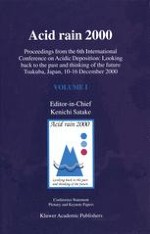2001 | OriginalPaper | Buchkapitel
Estimation of the Maximum Critical Load for Sulfur in South Korea
verfasst von : Soon-Ung Park, Young-Hee Lee
Erschienen in: Acid rain 2000
Verlag: Springer Netherlands
Enthalten in: Professional Book Archive
Aktivieren Sie unsere intelligente Suche, um passende Fachinhalte oder Patente zu finden.
Wählen Sie Textabschnitte aus um mit Künstlicher Intelligenz passenden Patente zu finden. powered by
Markieren Sie Textabschnitte, um KI-gestützt weitere passende Inhalte zu finden. powered by
The maximum critical load of sulfur and its exceedance by the sulfur deposition of 1994-1997 were mapped for South Korea with a spatial resolution of 11 X 14 km using the steady-state mass balance method. The Korean soil and geological maps were used as basis for the estimations of the critical alkalinity leaching and the weathering rate of base cations. The normalized difference vegetation index data obtained from the Advanced Very High Resolution Radiometer (AVHRR) together with the observed primary productivity of plants were used for the estimation of the critical uptake of base cations. Wet deposition of the non-sea-salt base cations was derived from measured base cation concentrations in precipitation, precipitation rate and air concentration of total suspended particulate while dry deposition of base cations was estimated using the inferential technique using scavenging ratios. The predominant ranges of base cation weathering, uptake and deposition were estimated to be of 200 – 600 eq ha-1 yr-1, 200 – 400 eq ha-1 yr-1 and 400-600 eq ha-1 yr-1, respectively. Critical alkalinity leaching was mainly in the range of 1000 – 2000 eq ha-1 yr-1 due to relatively high value of precipitation runoff. Exceedance of sulfur critical load was found at 40 % of the ecosystems considered mainly in the southeastern part of Korea, and about 60 % of Korea ecosystems were sustainable against sulfur acidity loadings.
